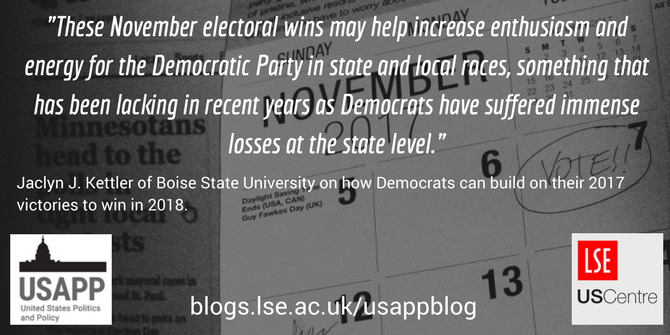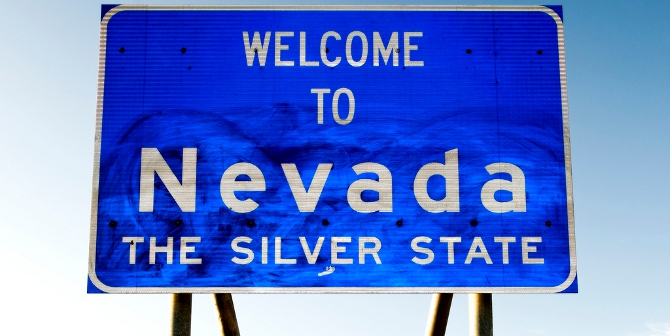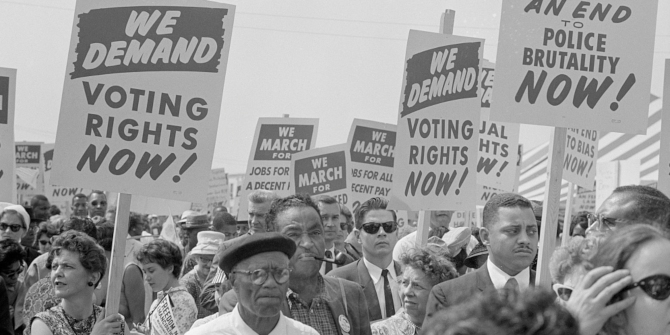 Democrats met with resounding success this week in elections across the country, including retaining the governorship of Virginia and gaining it in New Jersey. But what do these victories mean for the Congressional mid-term and state elections in November 2018? Jaclyn J. Kettler writes that President Trump’s poor approval rating has mobilized more Democrats to run for office, campaign and to vote. If the party can capture this momentum and maintain it over the coming year, then 2018 may see the party grow their numbers in state governments, further reinforcing the party in the long run.
Democrats met with resounding success this week in elections across the country, including retaining the governorship of Virginia and gaining it in New Jersey. But what do these victories mean for the Congressional mid-term and state elections in November 2018? Jaclyn J. Kettler writes that President Trump’s poor approval rating has mobilized more Democrats to run for office, campaign and to vote. If the party can capture this momentum and maintain it over the coming year, then 2018 may see the party grow their numbers in state governments, further reinforcing the party in the long run.
This week’s elections have brought some much-needed gains for the Democratic Party across the US. Democrats won two high-profile gubernatorial elections in New Jersey and Virginia, picking up at least 14 seats in the Virginia House of Delegates, pulling the party close to tying the number of seats held by Republicans. In Washington State, Democrats won a special election for a state senate seat, flipping the seat and securing a majority in the chamber. Democrats also experienced some success in local elections throughout the country.
While the Democrats were hopeful in several special elections earlier this year, the Democratic candidates ultimately lost those races. These November electoral wins may help increase enthusiasm and energy for the Democratic Party in state and local races, something that has been lacking in recent years as Democrats have suffered immense losses at the state level.
The party of the president almost always loses seats in the following midterm election. There are several theories as to why this might be the case, including a decline in turnout among voters supporting the president. For wave elections with large gains for the opposing party, many citizens are mobilized by their dislike or unhappiness with the sitting president; in effect, a mid-term election often acts as a referendum on the president. While the 2008 election was great for many state and local Democrats, the Republican wave in the 2010 election, fueled by a rejection of Democratic policies and disapproval of President Obama, helped Republicans gain significant advantages in state legislatures. Continued Republican gains in the 2012, 2014, and 2016 elections resulted in Republican control of both chambers in 32 state legislatures and 33 governorships. The Obama years were tough for Democrats at the state level.
Trump’s low approval ratings, particularly among Democrats, may now be mobilizing Democrats to run for office and to vote. In addition to key congressional races (with a growing number of Republican retirements), 36 states will have gubernatorial elections in 2018. Republicans currently hold 26 of these seats. These provide Democrats with some good opportunities to pick up seats in the midterm election, especially in state elections. Recent research by Steven Rogers demonstrates the impact of national politics on state elections. State legislative members in the president’s party face more challengers when the president is unpopular. Moreover, presidential approval has a significant influence on citizens’ vote choice in state legislative elections. Considering the usual midterm losses for the party of the presidency, potentially renewed energy among Democratic candidates, and the Democratic wins on November 7, the 2018 election looks to be a good year for Democrats.

“CD2: Election Day” by Thiophene_Guy is licensed under CC BY NC SA 2.0
If the Democrats can increase their numbers in state legislatures in 2018, it will allow party members to have more control over state policy. State legislatures are now very active and influential in many policy areas, making it important for parties to play a role in state policymaking. Moreover, the power and role of governors has grown, making them important positions to hold as well. Due to major Republican gains at the state level, Democrats have struggled to be relevant in many states in the last few years, which has limited their influence on policy. Moreover, redistricting is coming up soon after the 2020 census. State legislatures in many states control the redistricting process with some role for governors, making gaining control of more legislative chambers an important goal for Democrats.
Additionally, state offices are important pipelines to higher office. Many members of Congress and statewide officials started their political career in state legislatures. Due to their losses in the last several election cycles, the Democratic pipeline for statewide and national offices is limited. This is making it difficult to find candidates for potentially vulnerable districts. Any uptick in momentum going into the 2018 election may help the Democratic Party recruit candidates for a variety of offices, refilling the pipeline for higher offices in future elections.
Another important element of Democratic wins on Tuesday is the diversity of their successful candidates. Women, minority, and LGBTQ candidates won key state and local races. For example, 11 Democratic women beat Republican incumbents in Virginia’s legislative races. Since the 2016 election, there has been a significant increase in the number of women expressing interest in running for office. The greater number of women candidates in this week’s races, and their success, suggests if the 2018 election is a Democratic wave election – we may see an impressive growth in the diversity in elected officials in the US.
For Democrats to benefit from potential advantages in the 2018 election, the party needs to have candidates running for a variety of offices. While Democrats are having problems recruiting candidates in some vulnerable congressional districts, they are seeing a surge in people interested in running for office in some states. Democrats need challengers in races to capitalize on an unpopular president. The Democratic Party, especially state and local party committees, also needs to work on mobilization efforts.
Although the situation currently looks good for the Democrats heading into 2018, we are still a year away from the congressional midterm elections. A year is a lifetime in politics, so much can happen before then. But the 2018 midterm elections look to provide the Democrats with good opportunities to win some key races, and grow their numbers in state governments. Moreover, it is likely that this week’s results will provide the Democrats with more momentum, raising questions for how the Republicans will respond.
Please read our comments policy before commenting.
Note: This article gives the views of the author, and not the position of USAPP – American Politics and Policy, nor of the London School of Economics.
Shortened URL for this post: http://bit.ly/2hpkEwc
_________________________________
About the author
 Jaclyn J. Kettler – Boise State University
Jaclyn J. Kettler – Boise State University
Jaclyn Kettler is an assistant professor at Boise State University in the Department of Political Science. Her research interests include state politics, political parties, campaigns & elections, and women in politics. She is broadly interested in the intersection of US electoral and legislative politics.






